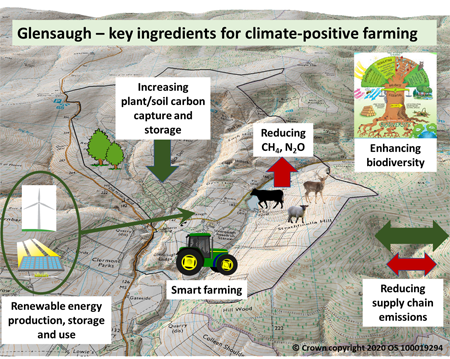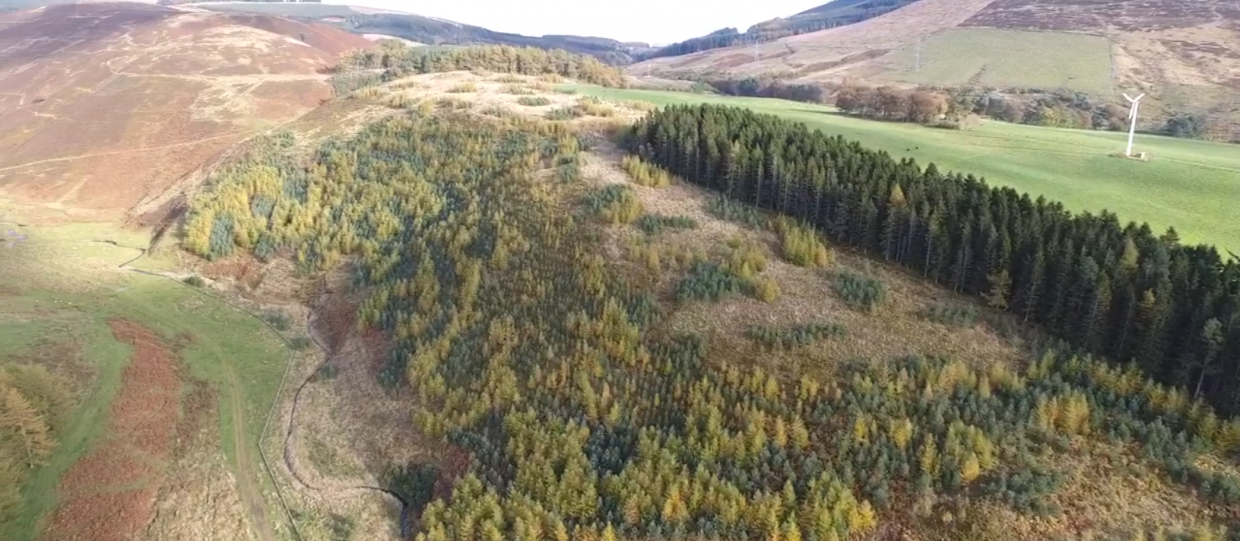
Trees and woodlands have an important role to play in capturing and storing carbon. They can also provide multiple other benefits - these include species and habitat diversity; landscape enhancement; livestock shelter; construction timber; wood fuel and other woodland products; enhanced water quality and flood mitigation.
The UK and Scottish Governments have set ambitious goals to increase overall woodland cover to sequester more carbon and help progress towards the net-zero targets.
Integrating more trees into farming systems will make an important contribution to these goals whilst also giving benefits to many different elements of the farming system.
Glensaugh currently has around 17% woodland cover (170 ha) and is actively expanding this resource, with the newest 100 ha planted in 2021-22 (supported by funding from the Macaulay Development Trust and the Scottish Government Forestry Grant Scheme). All woodland management on Glensaugh aims for multiple benefits - carbon sequestration, biodiversity, timber and biomass, shelter and more. The 78 ha Redstones area in the north-west of Glensaugh has been jointly planted with Fettercairn Estate across both adjacent land holdings. For more information on the scheme please contact Donald Barrie.
By directly addressing some of the synergies and potential conflicts with existing land uses and management of the farm business through our associated research, we will use the learning to inform this and future decisions relating to integrating woodland expansion as part of a farm business.
Considerations include:
Location - to suit multiple purposes - selecting sites that will deliver combinations of benefits for Glensaugh, including good tree growth rates for net carbon gain (but prioritising native species in many areas); visual amenity; connectivity and net biodiversity gain; provision of shelter; spatial integration with grazing land (agroforestry) to maximise livestock management benefits.
- Tree species choice - matching species to site and soil types; achieving biodiversity benefits; planning for short- and longer-term forest products (e.g. early biomass fuel crop, species for long-term retention); nurse crops for slower growing higher-value species such as oak (for timber, biodiversity, resilience to future climate change...).
Glensaugh is a key site in our Institute's active programme of research on woodland expansion for multiple benefits, including carbon, biodiversity, landscape etc. This spans multiple scales - from landscape-scale modelling to aid decision-making; pine provenance and resilience to climate change, pests and diseases; to detailed measurements of above-and below-ground changes in carbon, species composition etc during succession from open ground to woodland, and integrating agroforestry into farm livestock systems.
We have several joint research projects with the Universities of Aberdeen, Edinburgh and Stirling, and Aberdeen, and Forest Research, with important discoveries challenging some of the assumptions about net carbon gains and helping to better-inform decision-making in this important area.
You can find more information on specific projects on our "Research Highlights" pages.

